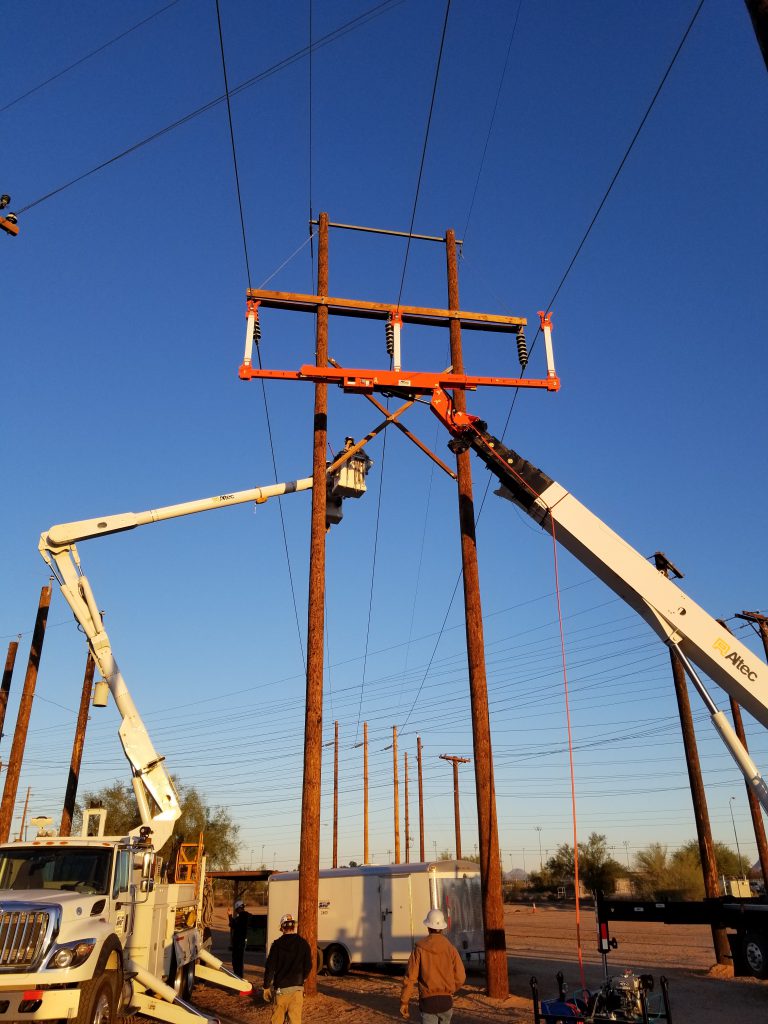By Trent Bevier, Transmission Line Construction Supervisor, Salt River Project

As any lineman knows, transmission outages are hard to come by—especially with the tightening of federal rules and regulations. Even so, line crews must get their work done swiftly and safely to help alleviate the loading on transmission lines.
To help save time in the field and protect their workforce, utilities are looking for new equipment as they upgrade and harden their systems. For example, line crews for Salt River Project (SRP) in Arizona were tasked with performing a significant amount of 69 kV pole changeouts and 115 kV and lattice work without taking an outage. About a year ago, SRP contacted LineWise, the utility products division of Diversified Products, to try out the Triple Line Lifter, a manual prototype. Then, just recently, the utility learned about a new fully hydraulic arm offered by the company—the TLL-1300 Triple Line Lifter.
This product helps line crews to save time and resources when performing maintenance work, which requires lifting conductors. They can use the TLL to replace wooden structures with steel, raise structures to comply with federal codes, change out insulators, or replace crossarms on a wooden structure.
Discovering Applications
After trying the TLL out in the field, the SRP crews have been using the product for many different applications, but mostly for subtransmission 115 kV work. In this configuration, conductors are staggered on both sides with two phases on one side of the pole and one phase on the other side of the pole.
Before SRP invested in the TLL, the SRP linemen conducted all 69 kV and 115 kV work on an outage, but now they can perform this work energized.
The linemen can use the TLL to handle energized conductors and for de-energized work. For example, linemen must maintain their clearances and check adjacent structures. Oftentimes, however, the clearances between subtransmission and distribution lines can create a hazard. As such, linemen must be very aware of adjacent structures and ensure they can move the conductor to the proper position when lowering and raising the conductor.
Setting Up the Device
The TLL is transported to the jobsite on a trailer in a self-contained transportation skid. The unit consists of two separate parts: the arm and hydraulic power unit.
Once on site, the linemen attach it to one of their cranes depending on the height of the conductors. SRP fitted the TLL to its 40-ton Altec crane.
Next, the linemen drop the arm, attach it to the frame, and then take it up and go to work. The time it takes for a crew to set up, get into the air and work can take less than an hour on average. The process is fairly straightforward, and the arm is easy to attach to the crane.
Training Crews
Currently, the journeymen linemen are using the TLL and running the arm with a remote, which can be used from the ground or in the air from a bucket. Linemen can take a horizontal line and roll it to vertical, or they can take a vertical line and roll it to horizontal. During a construction project, linemen can pull out the arms to spread out the conductor, move apart the old structure and tilt and articulate the arm. In addition, they can manage the conductor in a lot of different ways to access whatever structure they need to work on.
When SRP first purchased the TLL, LineWise provided a three-day training session. During this course, the linemen learned about the basic assembly, clearances, the amount of weight they could pick, capabilities and limitations. Also, they received instruction on the proper operation and maintenance required. LineWise provided the training on how to use the unit, and then the SRP crews determined how they could best use the product in their own work procedures.
SRP has two Triple Line Lifters, and in the future, it plans to continue to use them for energized 69 kV and 115 kV work. During the summer time, when outages are limited, the device has many benefits.
With the TLL, the SRP linemen can get their work done despite the restrictions on outages. Rather than sitting and waiting for an outage to be cleared, they can instead keep the lines energized and be able to maintain the transmission system.
This article was featured in the November 2018 Issue of T&D World
Leave a Reply